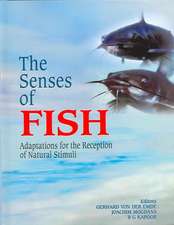Biological Clock in Fish
Editat de Ewa Kulczykowska, Wlodzimierz Popek, B. G. Kapooren Limba Engleză Paperback – 21 oct 2019
What is so special about the clock in fish? Where is it located—in the retina, inside the brain, or in the pineal? What is the molecular basis of its function? How is the clock able to keep time in the absence of environmental cues?
Although biological clocks have been intensively studied over the past four decades, only recently have the tools needed to examine the molecular basis of circadian rhythms become available. This book reviews the state of knowledge in sufficient detail and presents the latest contributions to the field, showing fish provide a unique model of the circadian biological clock.
| Toate formatele și edițiile | Preț | Express |
|---|---|---|
| Paperback (1) | 370.25 lei 6-8 săpt. | |
| CRC Press – 21 oct 2019 | 370.25 lei 6-8 săpt. | |
| Hardback (1) | 1275.71 lei 6-8 săpt. | |
| CRC Press – 27 mai 2010 | 1275.71 lei 6-8 săpt. |
Preț: 370.25 lei
Preț vechi: 477.20 lei
-22% Nou
Puncte Express: 555
Preț estimativ în valută:
70.85€ • 74.16$ • 58.97£
70.85€ • 74.16$ • 58.97£
Carte tipărită la comandă
Livrare economică 31 martie-14 aprilie
Preluare comenzi: 021 569.72.76
Specificații
ISBN-13: 9780367383954
ISBN-10: 0367383950
Pagini: 280
Dimensiuni: 152 x 229 mm
Greutate: 0.45 kg
Ediția:1
Editura: CRC Press
Colecția CRC Press
ISBN-10: 0367383950
Pagini: 280
Dimensiuni: 152 x 229 mm
Greutate: 0.45 kg
Ediția:1
Editura: CRC Press
Colecția CRC Press
Public țintă
Professional Practice & DevelopmentCuprins
Introduction to Circadian Rhythms. The Pineal Organ of Fish. Pineal Photoreception and Temporal Physiology in Fish. Melatonin in Fish: Circadian Rhythm and Functions. Fishing for Links between the Circadian Clock and Cell Cycle. The Pineal Gland as a Source of Melatonin in Fish, and Influence of Light and Temperature on Melatonin Secretion. Cellular Clocks and the Importance of Light in Zebrafish. Feeding Rhythms in Fish: From Behavioral to Molecular Approach. Reproduction Rhythms in Fish. Influence of Melatonin on Hypothalamo-Pituitary-Ovarian Axis in Carp: Mechanism and Action. Circadian and Seasonal Rhythm in Secretion of Melatonin, Dopamine, and LH in Carp. Circadian Clocks in Retina of Goldfish.
Notă biografică
Ewa Kulczykowska is head of the Department of Genetics and Marine Biotechnology in the Institute of Oceanology at the Polish Academy of Sciences in Powstanców, Warszawy, Poland.
Wlodzimierz Popek is a professor in the Department of Ichthyology and Fisheries at the University of Agriculture in Krakow, Poland.
B.G. Kapoor is a former professor of zoology at Jodhpur University in India.
Wlodzimierz Popek is a professor in the Department of Ichthyology and Fisheries at the University of Agriculture in Krakow, Poland.
B.G. Kapoor is a former professor of zoology at Jodhpur University in India.
Descriere
Although circadian biological clocks have been intensively studied over the past four decades, only recently have the tools needed to examine the molecular basis of circadian rhythms become available. Examining the unique model of biological clocks in fish, this book reviews the current state of knowledge in detail and presents the latest contributions to the field. It investigates the location, molecular basis, and mechanism of circadian clocks in fish as well as how they can function even in the absence of environmental cues.










